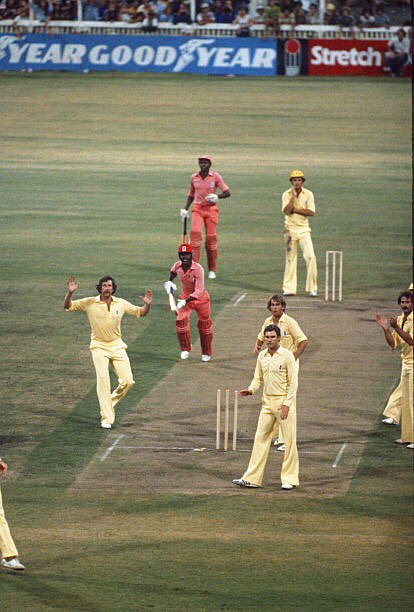Kerry Packer, father of ‘modern-day revolutionised’ cricket

Way before the Indian Premier League was even a thing, it was Kerry Packer who shaped the game for both the players and the audience. While they were treated to fantastic cricket on-field, it was more about how these games were televised - which truly is the series which changed cricketing history.
The year was 1977 and the screens were still in black and whites - in limited proficiency. While England were host to the first-ever Cricket World Cup, it was won by the dominant West Indian side, all in select TV screens that were available. Everything was longer, the shirts, the screens and, more so, overs played. While International cricket was revered and well-respected, it still needed a change - a revolution to turn things around.
And, it was the World Series Cricket, (WSC) as it was called which revolutionized the way cricket has been looked at since then. There were two factors that tilted some of the top-stars towards the controversial league - it was money and the opportunity which will help them to be financially stable. But, what was there for Kerry Packer? For Packer too, there was money on the line, more than ever and potentially, the exclusive rights to Australian cricket. It was at the same time that Australian cricket was starting to grow, more than ever. Then, it was held by the Australian Broadcasting Commission (ABC).
A man in his 30’s, Packer never started the league to be a competitor to International cricket, rather make his presence felt in the international arena. He initially signed as many as 30-international stars for his league, with the concept of pitting Australia against the Rest of the World (ROW). Tony Greig, Derek Underwood, Alan Knott and John Snow were all part of the notorious league.
On the other hand, there were World Cup winners in the form of - Clive Lloyd, Viv Richards, Gordon Greenidge, Andy Roberts. It then became into a festival for cricket fans - given that there was the presence of a star-studded line-up for the Australian audience. Till then, it was important to understand how cricket really was broadcasted. In the earlier times, if you look at all the highlights it will show the game from one angle - behind the bowler’s arms. It never changed till the league itself.
Till then, replays was a distant reality, with the game continuing from one and only end. Another impactful change that was a result of the league was that it was more accessible. How? While international cricket started early in the day, it meant that people have to miss work, leave their office early in order to catch a glimpse of the game. Well, they could only see a glimpse - thanks to the timings.
That is where, Packer’s series came in as a game-changer, with the games being played under lights. Floodlights also played a huge role as now games were played during the evenings, which ensured that there were more spectators at the event. For twenty years in Australia’s cricketing past - they have found broadcasters in ABC, who was the corporation that Packer so wanted to move out of his way.
All of this happened under the nose of the cricketing boards including the home board in Australia. The traditional white was replaced for the colours - which was a surprise to cricket, some said it was a pleasant one. The traditional pitches were replaced by a drop-in one, which seemed to have no-offer whatsoever to the bowling-friendly ones that existed in International cricket.
It was made for entertainment - with the sole purpose of attracting more people towards either of their TV screens or to the format that was played. It was the first time in International cricket that pitches were being prepared in a very short span of time. The reason behind it was the curator John Maley, who pioneered the ‘drop-in’ pitch which soon was in full swing in International cricket.
Players, on the other hand, were earning 210 pounds per Test while in WSC they earned over 1,000 pounds in the tournament. The entire concept of franchise cricket and the way people looked at how cricket was played all were shaped by a businessman - whose only goal was to get the Australian broadcasting contract.
While it happened at the same time some of the International series was happening - India vs Australia, it surely did not attract as much audience in the ground. But, nevertheless, the success came off in the broadcast viewing figures - which was more than ever. While it was not all glory for Packer, as he was still unable to use the terms ‘Test,’ or teams by their own names, or in modern-day, it was like PES 6. But that did not stop them and him from going through.
Moreso, if you think that was all it could offer to International cricket, it was not it. If you remember keenly, prior to the World Cricket Series, never was the helmet used by a cricketer. And, it was all happening in the presence of bowlers who were bowling at a pace that could compete for the best of current-day bowlers, or even more. It was in the World Cricket Series, where helmet came into play when Australian David Hookes was hit by the West Indian Andy Roberts.
It did not stop there, unfortunately, it led to many more controversies - including the resignation of Clive Lloyd as a captain from the West Indian national team. A league-type format also meant that the players had to put in more efforts to staying fit across the length of the tournament. Field restrictions were in play, making the players more athletic than ever, which is what in the crux, the IPL is all about. In the end, he did win the contract for broadcasting Australia’s games. And, for what it has done to International cricket, we would never have seen a crazier person than Packer and a crazier idea than ‘World Cricket Series.’
